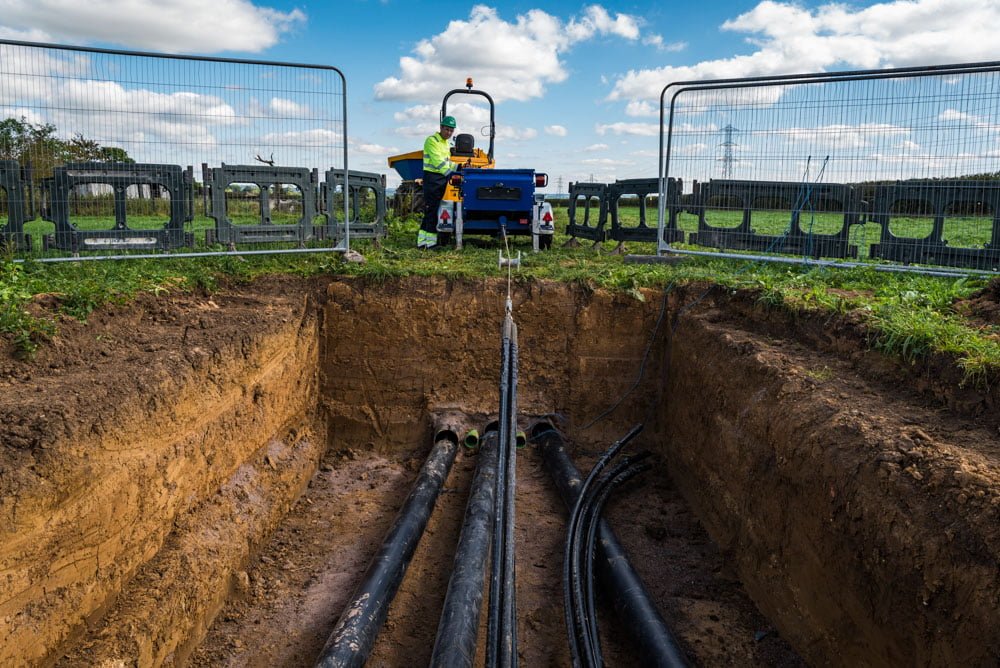New HV cable routes for infrastructure projects are sometimes hundreds of metres in length and cables must be pulled into place if installed into a pit and duct system, a process which can potentially cause damage to the cable or the duct in which it is run. By undertaking some careful cable pulling calculations we can avoid expensive and time-consuming setbacks for the entire project. Surprisingly, in our view, some contractors do not perform them, but it is a technique we invariably employ.
Excessive force when pulling cables into place can cause internal damage to the cable, resulting in either immediate failure, reduced lifespan of the cable, or additional maintenance. These cables are typically bespoke, taking about three months to manufacture, so if one is damaged during installation it’s not a simple case of reaching for the credit card.
The cable sheath and enclosing ductwork can also be damaged, meaning the cable itself is then exposed to further harm. The cable sheath and ducts are also there to protect workers and end users from the cable, so there is every reason to safeguard them.
A request from UK Power Networks Services
Some while ago, WCS was asked by client UK Power Networks Services (UKPNS) whether we could formally verify that the cable pulls that would be performed during a project would be safe. Software exists that will perform these calculations, but we decided that for maximum flexibility and transparency, it would be better to develop an in-house solution – a custom Excel template capturing all of the relevant factors and assessing the tension and pressure associated with each pull.
Senior Structural Engineer Aysegul Goren was tasked with the initial design of the template. “I was very familiar with cabling projects and the client asked us to look at this because they knew that the WCS team had the relevant experience. I talked at length with Nick Lowe, WCS Associate, and with Asa Whitfield, Managing Director, and the result was the first iteration of our bespoke cable pulling calculator.”
How cable pulling calculations work
The engineer performing the calculation enters all relevant information, specifying the nature of the cable (its weight, diameter, and other factors), facts about the duct compared to the cable (e.g., co-efficient of friction, and cable ratio – which defines how much room there is in the duct, so there isn’t jamming), as well as the length and geography of the cable route.
It’s important to emphasise that cable pulling calculations are not bi-directional. WCS always runs pulling calculations in both directions, to see which will stress the cable the most. Some important inputs to the calculation, such as friction, may be hard to identify precisely. WCS follows conventional practice in assessing those conservatively. Speaking of friction, it’s also worth emphasising that the lubricant used during a pull can be factored into the calculation.
The maximum tension that a cable can endure is specified by the cable manufacturer, but tension builds up over the length of a cable run, even a straight one. Bends multiply incoming tension and create sidewall pressure (on a straight pull, sidewall pressure is zero). Any cable run except a short one will be divided into segments, each of which will be pulled into place separately before being spliced onto the next section of cable.
We at WCS are civil engineers, and typically many of the factors involved in a cabling project, such as the characteristics of the cables involved, are specified by the electrical engineers we work with. “The start and end of the cable route are fixed factors from our perspective,” explained Civil Design Engineer Sesan Ogunbanjo, “and often there is limited flexibility regarding the precise route. Factors we can vary, if the calculations indicate a problem, include the number of separately pulled segments we will use over the route, and where the pulling pits for those are, and also the direction of a pull.”
From a calculation perspective, adding a new pull segment resets tension and pressure to zero, so an additional pulling pit can always be used to resolve difficulty. Each one adds cost, of course, so the goal is to verify that a cost-effective solution is safe. In other cases, the calculations may be able to offer a cautious client a cheaper solution than they were conservatively assuming, by confirming that fewer pulling locations than initially presumed will suffice.
What began as a request from a single client has become a valuable in-house resource for WCS. “Researching this area initially was very exciting for me,” explained Aysegul, “because I was learning and developing my knowledge. When I went back to other work, my colleague Sesan used the template, and he was able to add some additional functionality, so now we have a really robust tool that we can use over and over again, whichever client we’re working with.”

To find out more about Whitfield Consulting Services, please visit our contact page.
